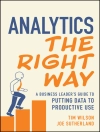Explore the essential steps for data collection, reporting, and analysis in business research
Understanding Business Research offers a comprehensive introduction to the entire process of designing, conducting, interpreting, and reporting findings in the business environment. With an emphasis on the human factor, the book presents a complete set of tools for tackling complex behavioral and social processes that are a part of data collection in industry settings.
Utilizing numerous real-world examples throughout, the authors begin by presenting an overview of the research process, outlining key ideas relating to the business environment, ethics, and empirical methods. Quantitative techniques and considerations that are specific to business research, including sampling and the use of assessments, surveys, and objective measures are also introduced. Subsequent chapters outline both common and specialized research designs for business data, including:
* Correlational Research
* Single Variable Between-Subjects Research
* Correlated Groups Designs
* Qualitative and Mixed-Method Research
* Between-Subjects Designs
* Between-Subjects Factorial Designs
* Research with Categorical Data
Each chapter is organized using an accessible, comprehensive pedagogy that ensures a fluid presentation. Case studies showcase the real-world applications of the discussed topics while critical thinking exercises and Knowledge Checks supply questions that allow readers to test their comprehension of the presented material. Numerous graphics illustrate the visual nature of the research, and chapter-end glossaries outline definitions of key terms. In addition, detailed appendices provide a review of basic concepts and the most commonly used statistical tables.
Requiring only a basic understanding of statistics, Understanding Business Research is an excellent book for courses on business statistics as well as business and management science research methods at the graduate level. The book is also a valuable resource for practitioners in business, finance, and management science who utilize qualitative and quantitative research methods in their everyday work.
Jadual kandungan
Preface
Acknowledgements
Part I. Overview of the Research Process
Chapter 1. Research and the Business Environment
Chapter 2. Ethics and Research
Chapter 3. The Foundations of Research
Chapter 4. An Overview of Empirical Methods
Part II. Nuts & Bolts of Research
Chapter 5. Writing the Research Report
Chapter 6. Reviewing the Literature & Forming Hypotheses
Chapter 7. Sampling
Chapter 8. Creating and Using Assessments, Surveys, and Objective Measures
Chapter 9. A Model for Research Design
Part III. Common Research Designs
Chapter 10. Correlational Research
Chapter 11. Between-Subjects Designs
Chapter 12. Single Variable Between-Subjects Research
Chapter 13. Between Subjects Fractorial Designs
Chapter 14. Correlated Groups Designs
Part IV. Special Research Designs
Chapter 15. Research with Categorical Data
Chapter 16. Qualitative and Mixed-Method Research
Appendix A. Statistics Behind The Research: A Review
Appendix B. Statistical Tables
Mengenai Pengarang
BART L. WEATHINGTON, PHD, is UC Foundation Associate Professor in the Department of Psychology at the University of Tennessee at Chattanooga, where he is also Coordinator of the Industrial-Organizational Psychology graduate program. Dr. Weathington is coauthor of Research Methods for the Behavioral and Social Sciences (Wiley).
CHRISTOPHER J. L. CUNNINGHAM, PHD, is UC Foundation Associate Professor of Industrial- Organizational and Occupational Health Psychology at the University of Tennessee of Chattanooga, where he is also Adjunct Clinical Assistant Professor of Internal Medicine in the College of Medicine. Dr. Cunningham is coauthor of Research Methods for the Behavioral and Social Sciences (Wiley).
DAVID J. PITTENGER, PHD, is Dean of the College of Liberal Arts at Marshall University. Dr. Pittenger is coauthor of Research Methods for the Behavioral and Social Sciences (Wiley).












